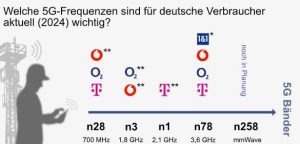How Do mmWave and C Band Frequencies Compare?
In the realm of 5G technologies, understanding the different spectrum bands, specifically mmWave and C Band, is crucial for grasping their roles and potential impacts on network performance and application. These bands represent distinct approaches to balancing the trio of coverage, capacity, and speed that are fundamental to 5G services.

mmWave: High Frequency with High Capacity
Millimeter wave (mmWave) frequencies are typically defined as those ranging from 24 GHz to 100 GHz. These high-frequency bands are capable of carrying a large amount of data, making them ideal for high-density areas where tremendous amounts of data need to be transmitted quickly. Key characteristics include:
- High Data Rates: mmWave can support incredibly high data rates, often exceeding 1 Gbps, which facilitates applications requiring intensive bandwidth such as virtual reality (VR) streaming and ultra-high-definition (UHD) video.
- Limited Coverage: The primary limitation of mmWave is its range and ability to penetrate obstacles. These waves tend to have a shorter propagation distance and can be significantly attenuated by buildings, foliage, and even rain.
- Infrastructure Requirements: To effectively utilize mmWave, a dense deployment of antennas and small cell networks is necessary, especially in urban environments where buildings can obstruct signals.
C Band: Balancing Speed and Coverage
The C Band typically refers to frequencies in the 4 GHz to 8 GHz range, but in the context of 5G, it often specifically denotes the 3.7-4.2 GHz segment. This mid-band spectrum is highly valued for its ability to balance coverage and capacity:
- Good Coverage and Penetration: C Band frequencies can cover larger areas than mmWave and better penetrate physical barriers, making them more suitable for suburban and rural deployments.
- High Capacity: While not as high as mmWave, the data throughput of C Band is significantly greater than lower frequency bands, making it ideal for a wide range of applications, including cellular broadband and fixed wireless access.
- Cost-Effective Deployment: Deploying C Band infrastructure is generally less expensive and complex than mmWave, as it does not require as dense a network of cells.
Comparative Analysis: mmWave vs C Band
When comparing mmWave vs C Band, the choice between the two depends largely on the specific needs of the area and the applications intended for use:
- Urban Centers: In densely populated urban areas, mmWave is preferable due to its high capacity and ability to handle numerous simultaneous high-data connections.
- Wider City Coverage and Suburbs: C Band is more suitable for providing robust coverage that extends beyond the dense city core into suburban areas, balancing speed with reach.
- Application-Specific Use: mmWave is tailored for scenarios that demand extreme bandwidth, such as large public venues and specific industrial applications, whereas C Band is versatile enough to support a broad spectrum of less intensive, but still data-demanding, applications.
Understanding the distinctions between mmWave and C Band frequencies helps stakeholders in the telecommunications industry make informed decisions about network design and deployment strategies. As 5G continues to evolve, the strategic use of different frequency bands will play a pivotal role in meeting the diverse requirements of global connectivity and advanced wireless services.
For a more detailed exploration of the differences and applications of these frequency bands, consider visiting this detailed resource on mmWave vs C band frequencies. This analysis offers insights into how each band can be optimally deployed to achieve the best balance of speed, coverage, and capacity in various scenarios.